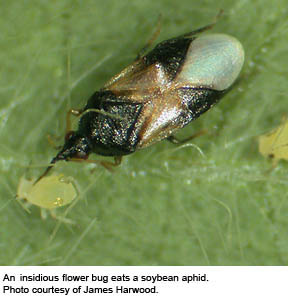Natural Predators May Be Best Soldiers in Soybean Aphid Battle
Natural Predators May Be Best Soldiers in Soybean Aphid Battle


Since 2000, the soybean aphid has caused many soybean producers in the United States a considerable amount of grief. The pest, native to eastern Asia, has spread to at least 20 states and provinces in the USA and eastern Canada, causing more than $600 million in crop damage. Add to that a $12 per acre cost of spraying fields to combat the aphid, and the soybean industry is dealing with a total cost of more than $750 million, which is increasing each year.
Researchers at the University of Kentucky and Purdue University are collaborating with the U.S. Department of Agriculture to find ways to win the soybean aphid battle.
“Before the soybean aphid was found in the United States, soybeans in the Midwest had rarely been attacked by a major pest” said James Harwood, UK College of Agriculture assistant professor of arthropod ecology. “So we’re trying to find ways now to control this pest, and we are looking at natural predators of the soybean aphid.”
Harwood and his colleagues are hoping their research, published in the October issue of Molecular Ecology, will provide a breakthrough in the fight against this invasive pest.
Through this research, an abundance of one of the soybean aphid’s natural enemies – the insidious flower bug – has been observed, especially early in the growing season. The flower bug feeds on the soybean aphid, among other things, and Harwood believes the bug may hold great potential in helping to control this major pest.
“We’re trying to find out if the bug is really feeding on the soybean aphid, and if so, how often. So we collect these bugs from soybean fields and examine their guts for soybean aphid DNA,” Harwood said. “Basically, we want to see who is eating whom.
“What we are seeing is that the predator (flower bug) is already there before the aphid arrives,” he continued. “So when the aphid does arrive, the predatory flower bugs feed on the aphids and potentially slow their rapid population growth.”
Harwood said the insidious flower bug is common throughout much of the eastern and central United States, and the question is really one of how to enhance its populations in soybean fields.
“We’re very interested in their ecology - what food resources they use and how they interact with other predators in the same location,” he said. “We have to also find out if manipulating biodiversity by providing alternative food sources has a major effect on the ability of these predators to feed on the soybean aphid. The last thing we want to do is distract it from the pest we want it to eat.”
Biodiversity is defined as the number and variety of organisms found within a specified geographic region.
Although the soybean aphid generally has not risen to damaging levels in Kentucky, the research could still benefit the state’s soybean producers.
“We need to find out why the soybean aphid population has a persistently low density in Kentucky,” Harwood said. “There’s no way to say there’s no chance of a sudden soybean aphid population explosion in Kentucky, and so we are trying to be proactive and keep that from happening.
“The soybean aphid’s main impact starts just a couple of hours north of here,” he continued. “Our neighbors in Indiana are having a tough time of it, so hopefully this research will give them the tools to fight it.”
Harwood said the soybean aphid problem is not going away. In fact, each year more producers in the major soybean producing states have to deal with the pest. If the soybean aphid populations are large, producers can see yield losses of up to 50 percent. Harwood said his team is looking not only at the insidious flower bug but at other natural predators, and how they interact with the soybean aphid.
“Really, for Kentucky, this research will hopefully serve as a model system,” he said. “If we know how to combat something like the soybean aphid, we can impact other invasive species as they arrive.”